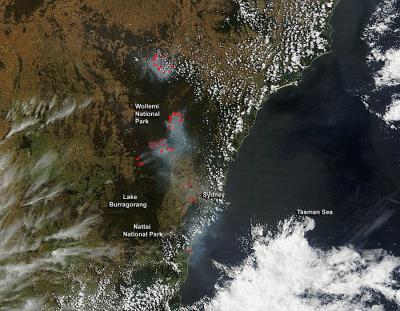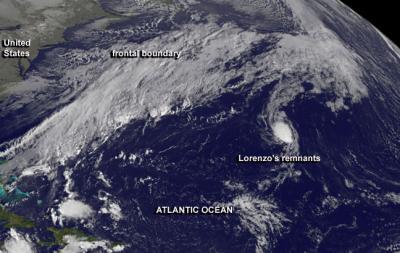(Santa Barbara, Calif.) –– An unintended legacy of California's gold rush, which began in 1848, endures today in the form of mercury-laden sediment. New research by Michael Singer, associate researcher at UC Santa Barbara's Earth Research Institute, shows that sediment-absorbed mercury is being transported by major floods from the Sierra Nevada mountains to Central Valley lowlands. The findings appear today in the Proceedings of the National Academy of Sciences (PNAS).
Heavens
Tropical Storm Raymond moved away from western Mexico and into warmer waters with less wind shear over the weekend of Oct. 26-27, where it strengthened into a hurricane again. NASA's Aqua satellite captured an eye-opening image of Raymond before it ran into strong wind shear.
The Moderate Resolution Imaging Spectroradiometer or MODIS instrument aboard NASA's Aqua satellite captured a visible image of Hurricane Raymond that showed its eye had re-developed and opened after it re-strengthened in the Eastern Pacific. The image was taken on Oct. 27 at 21:15 UTC/5:15 p.m. EDT.
The first tropical cyclone of the Southern Indian Ocean season lasted about one day. Tropical Cyclone 01S was born on Oct. 27 and by Oct. 28 had become a remnant low.
The first tropical cyclone of the Southern Indian Ocean cyclone season formed on Oct. 27 near 13.1 south and 63.4 east, about 570 nautical miles northeast of Port Louis, Mauritus. It was moving to the west-southwest at 7 knots. Maximum sustained winds were near 35 knots.
After emitting its first significant solar flares since June 2013 earlier in the week, the sun continued to produce mid-level and significant solar flares on Oct. 27 and Oct. 28, 2013.
Solar flares are powerful bursts of radiation. Harmful radiation from a flare cannot pass through Earth's atmosphere to physically affect humans on the ground, however -- when intense enough -- they can disturb the atmosphere in the layer where GPS and communications signals travel.
ALLENDALE, Mich. — Gender is no longer determined solely by biological factors, according to a new study by a Grand Valley State University researcher whose article, "Doing Gender, Determining Gender: Transgender People, Gender Panics, and the Maintenance of the Sex/Gender/Sexuality System," was recently published in Gender & Society.
Once a typhoon now an extra-tropical cyclone in the far northern Pacific Ocean, Lekima is weakening over cool waters. NASA's Aqua satellite captured the last image of Lekima as a typhoon before it weakened.
Children with poor motor performance at the school entry were found to have poorer reading and arithmetic skills than their better performing peers during the first three years of school. However, no relationship was found between cardiovascular fitness and academic skills, according to a new study published in Medicine & Science in Sports & Exercise.
NASA's Terra satellite detected dozens of bushfires continued raging in the Australian state of New South Wales, outside of Sydney. Sydney is the state capital and the most populated city in Australia.
According to CNN, emergency managers in New South Wales declared a state of emergency. On Oct. 22, CNN reported that New South Wales was battling 62 fires on Oct. 22. More than 116,167 hectares (~287,000 acres) have already burned.

Nanomaterials are the heart of the smaller, better electronics developed during the last decade, as well as new materials, medical diagnostics and therapeutics, energy storage, and clean water. However, exposure to nanomaterials may have unintended consequences for human health and the environment.
GRAND RAPIDS, Mich. — A group of students and faculty at Grand Valley State University have been working with Van Andel Institute to develop new methods to further a growing medical field that aims to improve early detection of cancer and disease.
A group of four Grand Valley students and graduates, and Anthony Chang from VAI, presented three years worth of research at the World Molecular Imaging Congress, one of the largest meetings in the medical imaging field, September 18-21 in Savannah, Georgia.
NASA's TRMM satellite observed Typhoon Lekima's shrinking eye on Oct. 24, and by the Oct. 25, the eye had shrunk to just 4 nautical miles. TRMM also observed very heavy rainfall occurring around the eyewall of the storm.
Cold air, mid-latitude westerly winds and wind shear are taking a toll on Tropical Storm Francisco and transitioning the storm into a cold core low pressure area. NASA's Terra satellite captured an image of Francisco as it spread a blanket of clouds and showers over Japan on Oct. 25.
South-central Mexico was inundated with heavy rains from Hurricane Raymond during the week of Oct. 20, and Raymond has finally weakened to a tropical storm and is moving away from the coast. Infrared data from NASA's Aqua satellite showed that the heaviest rainfall in the weaker storm was now away from the Mexican coast.
Satellite imagery on Oct. 25 showed a cold front approaching the remnants of Tropical Storm Lorenzo in the central Atlantic Ocean.
A visible image captured by NOAA's GOES-East satellite image showed the oval-shaped remnants of Tropical Storm Lorenzo east of a frontal system in the central Atlantic Ocean. The image was created by NASA's GOES Project at the NASA Goddard Space Flight Center in Greenbelt, Md.

Hot spots of mercury pollution in aquatic sediments and soils can contaminate local food webs and threaten ecosystems, but cleaning them up can be expensive and destructive. Researchers from the Smithsonian Environmental Research Center and University of Maryland, Baltimore County have found a new low-cost, nonhazardous way to reduce the risk of exposure: using charcoal to trap it in the soil.